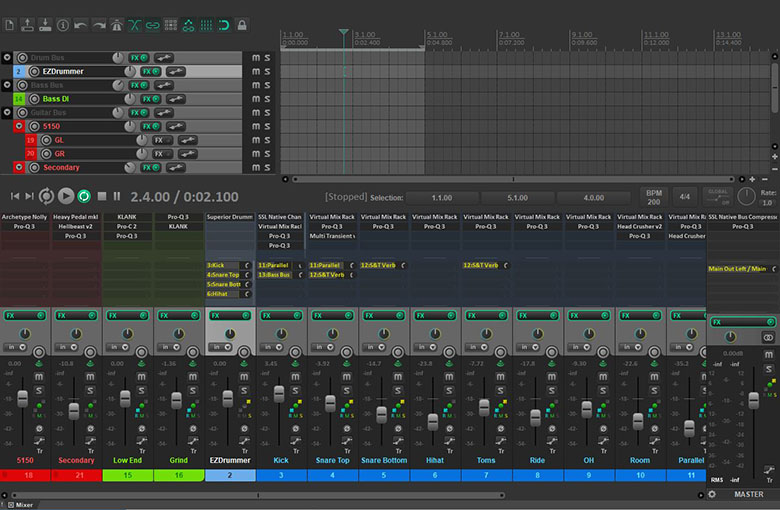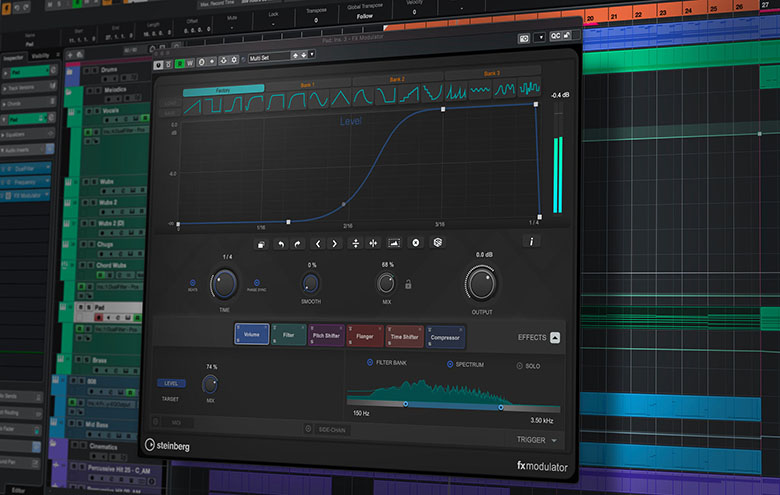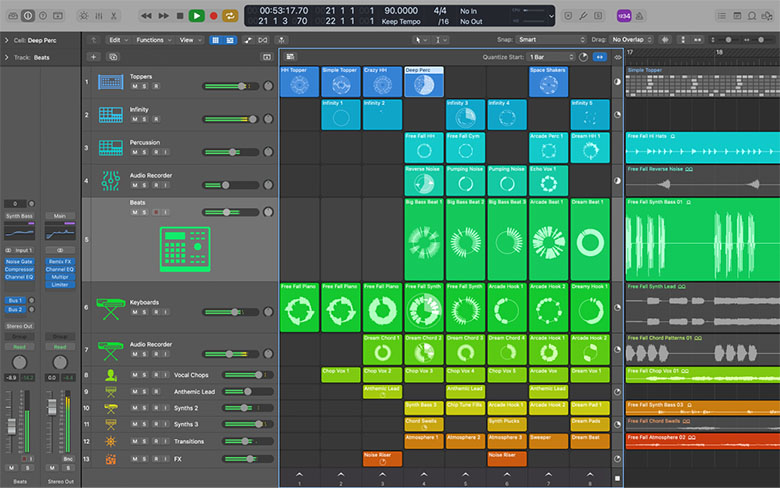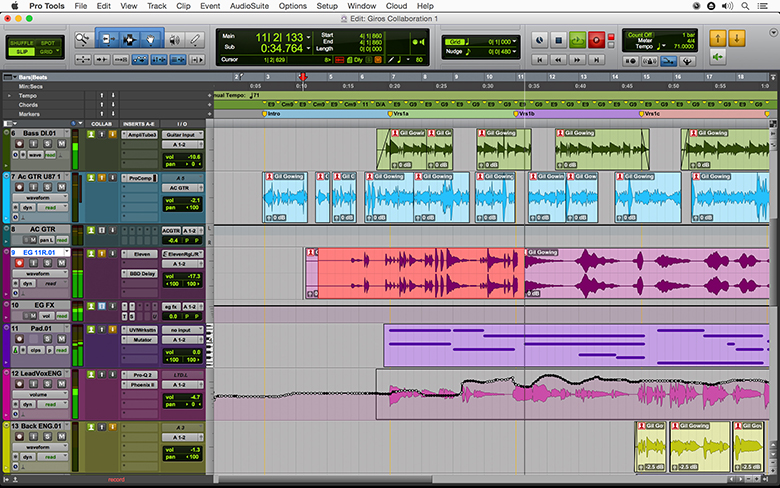In this article, I’m going to recommend a handful of my favourite DAWs (and one I don’t like) for recording and mixing metal projects.
Right upfront, I’ll admit that trying to identify the “best DAW for metal” is a somewhat silly approach. Bluntly, any software capable of multi-tracking audio, with MIDI features, that includes a selection of essential plugins for EQ and compression will get you 90% of the way there. The best bet for those starting out is to demo every DAW you can, and pick the one that you find most comfortable. Like buying shoes.
But this is a metal-oriented website, with a focus on novices, hobbyists and, to put it gently, musicians who don’t have a lot of disposable income. No one starts a death metal band and quits their day job, and few readers are going to find paying $389/year for Pro Tools Studio a viable option. Fortunately, you don’t need to. All of my recommendations are relatively inexpensive and capable of equally professional results.
That said, certain DAWs are designed with specific end-users and genres in mind. I don’t think it’s outlandish to acknowledge that those who produce electronic music, pop, or hip-hop tend to favour software that is fine tuned for tweaking synths, making beats, and sequencing than others. Abelton Live, Reason, and FL Studio come to mind.
DAWs favoured by rock and metal engineers/producers more closely mimic a straight-forward, traditional workflow and UI. Recorded tracks are sent to mixer, inserts or sends are used to shape them, and instruments are grouped or sent to buses for further processing.
Reaper

I’m a Reaper die-hard; I’m not going to pretend to be unbiased. A license is absurdly inexpensive for what you get, running you only $60 for personal use, but that doesn’t even factor into my allegiance. If I won the lottery tomorrow, I’d still use Reaper. If the price went up $200, I’d have to pony up. (And worth noting: there’s only one version of Reaper, unlike other DAWs that come in lighter, stripped down versions, the personal license and the commercial license offer the same functionality.)
Granted, there are things the industry mainstays like Steinberg’s Cubase and Presonus’s Studio One do better, but not better enough that I’ve been convinced to make the switch.
The UI and workflow are nothing ground-breaking, but feature a few nuances that I personally find very useful. For example, instead of buses, Reaper embraces folders, which come in very handy when arranging and organizing a lot of tracks. In practice, they’re not much difference than buses, and the difference might sound semantic, but the advantage becomes clear very quickly.
For example: I will often have five guitar tracks. That’s quad-tracked rhythm guitars, plus a track for leads. The way they’re organized:
- My primary guitar tone is two tracks of DIs panned hard left and right, which are placed in a folder called Primary Guitar. I add my amp sim, EQ, and other effects directly to this folder, which are applied to the DIs, allowing me to apply a single instance of the amp sim to both tracks simultaneously.
- My secondary tone, intended to compliment the primary tone, also consists of two DI’s, usually hard left and hard right, placed in a folder called Secondary Guitar. Amp sims, EQ and effects are used to sculpt a tone that complements and rounds out my primary tone.
- My lead is recorded to its own individual track named Lead.
- I move the Primary Guitar folder, Secondary Guitar folder, and Lead track to a top-level folder I name Guitar Bus for further processing.
- When I’m ready to move on from guitars and work with bass or drums, I collapse the folder in my arrangement window. Out of sight, out of mind. Simple and clean.
Another feature of Reaper I find tremendously useful is way looping audio and MIDI is implemented. For songwriting and demos, Reapers’s approach is is invaluable, and the probably the main reason I’ve stuck with it all this time.
You can record one take of a riff, trim it to the measure, and then render it (or glue it) into a looping part. Then you can drag the the beginning or the ending of that part to loop the piece for two measures, three measures, and so on until infinity. I wouldn’t necessarily take that approach on an album (kind of cheating, right?), but it’s a great way to write and arrange your compositions quickly. Other DAWs do offer similar looping functionality, but their solutions are not as intuitively implemented, or as effortless.
The large library of effects included with Reaper are also of high-quality, and give you results that hold up against even the most revered third-party plugins. In fact, it comes with everything you need to to mix a recording without even have to touch a third-party plugin.
But that brings me to some of the potential drawbacks. While many high-profile DAWs include plugins that mimic the appearance of hardware along with their function, Reaper plugins are about as nondescript as you can get. The plugins are operated by sliders, numbers, and the uninspiring grey buttons comparable to those you’d find in the settings box of a open-source video player. This hardly impacts their usefulness and quality, and it’s a superficial complaint–but I do sometimes find myself wishing they were more polished. For inspiration or something. I don’t know.
Likewise, the design of the DAW itself leaves a bit to be desired. You can download themes for Reaper, and there’s a lot of themes out there—but the good ones are few and far between. Most audio engineers are not designers, and even the Default theme for version 6.0 underwhelms. Again, not a deal-breaker, but I can certainly understand why someone who loads this up for the first time might be misled.
On the bright side, there’s no doubt a focus on substance over style, in small part, contributes to Reaper’s impressive performance. It’s easier on the CPU than any other DAW I’ve used, and I rarely experienced a crash—when I have, it’s been due to stressing out my RAM with a too-large sample library.
Finally, I should note the Reaper community. The DAW is regularly updated with fixes and additional features, and the forums are an invaluable resource with tons of helpful people.
Studio One Artist/Professional

I’m relatively new to this DAW. I received a license for Studio One Artist a little over a year ago with the purchase of a Presonus ioStation audio interface and control surface. And although I’m a Reaper fan, I always like to try new things—just in case I’m missing out on something.
And it turns out Studio One Artist really is a fantastic DAW, and has now overtaken Cubase as my second choice DAW for PC. In truth, it’s very similar to Cubase, and anyone moving from Steinberg to Presonus is likely to feel right at home pretty quickly. Window layout and management is nearly identical.
Compared to Reaper, Studio One looks great. The UI of this software is highly polished—this is the best looking DAW, in my opinion, if that sort of thing matters to you–and the user experience is nearly flawless. A common complaint from users who move to Reaper from another DAW is that Reaper is not particularly intuitive, and sometimes confusing. I don’t see it—one some level, a DAW is a DAW, and the workflow and functionality isn’t dramatically different from one to another–but it comes up often in forums and reviews that it seems worth mentioning.
I primarily use Studio One for drum programming. The MIDI editor seems to work more intelligently than the one in Reaper. Sometimes when I’m placing notes in Reaper’s MIDI editor, it will snap them to a beat before, or a beat after, my intended placement. This could be chalked up to my own lack of precision with the mouse; but for whatever reason, Studio One seems capable of reading my mind. I rarely have to do any adjustments after the fact. Every note lands where I want it to land. Who knows? At any rate, the entire program is like this: it’s truly a pleasure to work with.
While does lack the effortless audio & MIDI looping capability of Reaper, but you can accomplish the same thing in a slightly more roundabout way. MIDI can be converted to patterns, although I’m a bit puzzled by this extraneous step. Audio is looped by duplication. And while Studio One offers support for both both dedicated bus tracks and folders, I don’t like the folder implementation in Studio One quite as much.
If you haven’t been lucky enough to score it for free, as I did, the Artist version of Studio One with set you back a very reasonable $99. There’s limitations on this slimmed down version, but Presonus has wisely cut out only the features that are genuinely more useful to professional use anyway. There’s no restriction on track count, bus count, or the number of effects plugins you can insert into a single track. That’s rare for an entry-level DAW from a major developer. Steinberg isn’t do generous.
And here’s something else that’s pretty cool: if you do think the extra features of Studio One Professional would come in handy, Presonus will give you access to it, and everything else they have to offer—tons of plugins, sample libraries—for a the price of a $14.95 monthly subscription. Less than standard subscription to Netflix, to put it into perspective.
Cubase Elements/Atist/Professional

Cubase was my first DAW. When I was going to school for audio engineering and production in the 90s, we largely used it in tandem with hardware synths for sequencing.
But that changed in 1996, with Steinberg’s introduction of VST technology. Being able to insert real-time effects without hardware was extremely exciting, even if the performance and results were a bit spotty early on.
Along with Reaper and Logic Pro for OSX, this is a favourite DAW of metal producers and musicians and is undoubtedly used more frequently professionally than the other two. German producer Kristian “Kohle” Kohlmannslehner of Kohlekeller Studio, who has become prominent on YouTube and is responsible for many fantastically brutal productions (Aborted, Benighted), appears to work primarily with Cubase.
I have Cubase Elements 12—which is all I need. But unlike Studio One Artist, Elements does introduce some limitations you’ll want to take into consideration, unless you spring for the Pro or Artist editions. Elements (the entry-level edition at $150) restricts the number of MIDI tracks to 64, and the number of audio tracks to 48, for example.
But listen, I’ve been dabbling in this for a long time, and I don’t think I’ve ever required 48 audio tracks for a project, even when micing up a full acoustic drum kit.
Maybe you’ve got it in mind to record an orchestra for your symphonic black metal band, but I’d discourage you from doing it in your basement home studio anyway. It’d be weird for everyone.
Logic Pro & Garage Band

So that brings us to Logic Pro. In 2014 I switched from PC to Mac. I was seduced by those new iMacs. I grew to love OSX, and even after returning to the PC world, still prefer OSX to Windows.
But then in 2017 the iMac’s fan started making a hideous cranking and clanking noise. I couldn’t open it up to fix it, or I would void the warranty, and by doing so would likely have destroyed it anyway. They really don’t want you getting into those things. So I sent it for repair, which took three weeks. A few days after I got it back I sold it and bought a PC.
Logic Pro is probably only second to Pro Tools in terms of industry saturation, and in my opinion, is a better DAW than Pro Tools, if only (but not only) because it supports VST. This DAW scores high on usability, which is unsurprising for an Apple product, and is my top-pick for OSX. (After Reaper, of course. That’s right.)
It’s a bit expensive for hobbyists and beginners at $279, although that’s surprisingly reasonable, considering that it’s an Apple product, and given it’s reputation and quality. The included plugins are all top-of-line, meaning there’s less reason to spend a lot on third-party plugins.
Garage Band—Logic’s little brother—is a free option for OSX, but I think it’s too limited for recording and mixing ambitious projects. It’s a good starting point for beginners, and for songwriting, recording demos, or recording a live performance on the road, undoubtedly useful.
Pro Tools

It’s Pro Tools. It’s the industry standard, a lot of people use it, and even seem to like it. I do not, and interpret all enthusiastic support as a kind of Stockholm syndrome. But what do I know?
They tell me for large projects with dozens of tracks, if not hundreds of tracks, it’s impossible to beat. I’ve never worked on a project of that size.
The stability and performance can partly be traced to it’s AAX architecture, the AAX plugins being tightly controlled by Avid and optimized for the platform. While you can use VST plugins with a work-around (ReWire), there’s no native support, which makes something as simple as loading up a free VST amp sim a bit annoying.
So, yeah. I honestly wouldn’t recommend Pro Tools for anyone who isn’t actively pursuing a career in audio engineering. And that’s that. But I do need to mention it, because a significant portion of my favourite metal albums (and your favourite metal albums) were tracked an mixed with it.
